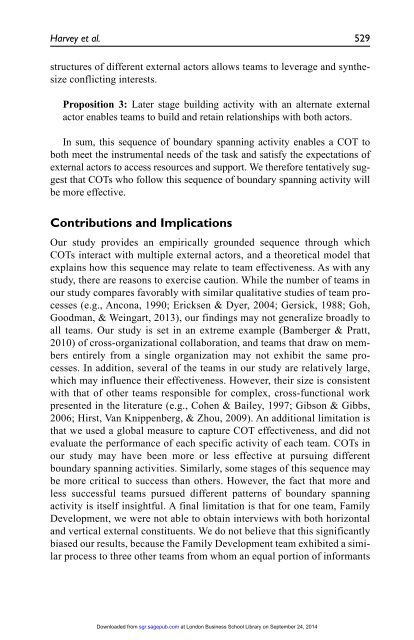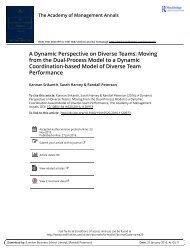The Process of Team Boundary Spanning in Multi-Organizational Contexts - Sarah Harvey, Randall S. Peterson, and N. Anand
Work teams must increasingly operate in complex environments characterized by multiple external actors beyond team and organizational boundaries. Although previous research demonstrates the importance of boundary spanning activities to team effectiveness, it reveals relatively little about the process of boundary spanning in these environments. In this article, we investigated the processes of boundary spanning across multiple external actors in 10 cross-organizational teams. We identified three sequences for reaching out to external actors: (a) moving inside-out from vertical actors inside the host organization to horizontal actors outside of the host organization, (b) moving outside-in from horizontal actors to vertical, and (c) staying-inside with vertical actors from the host organization. Our observations suggest that inside-out and outside-in sequences were more successful than simply pleasing the host organization. We build on our empirical findings to develop a process theory of how team boundary spanning activities across multiple external actors influence team effectiveness. Our research underscores the importance of a team’s interactions with actors in its external environment beyond those in an immediate supervisory role and provides insight into the dynamics of boundary spanning in multi-organizational contexts.
Work teams must increasingly operate in complex environments
characterized by multiple external actors beyond team and organizational
boundaries. Although previous research demonstrates the importance of
boundary spanning activities to team effectiveness, it reveals relatively little
about the process of boundary spanning in these environments. In this article,
we investigated the processes of boundary spanning across multiple external
actors in 10 cross-organizational teams. We identified three sequences for
reaching out to external actors: (a) moving inside-out from vertical actors inside
the host organization to horizontal actors outside of the host organization,
(b) moving outside-in from horizontal actors to vertical, and (c) staying-inside
with vertical actors from the host organization. Our observations suggest
that inside-out and outside-in sequences were more successful than simply
pleasing the host organization. We build on our empirical findings to develop
a process theory of how team boundary spanning activities across multiple
external actors influence team effectiveness. Our research underscores the
importance of a team’s interactions with actors in its external environment beyond those in an immediate supervisory role and provides insight into the
dynamics of boundary spanning in multi-organizational contexts.
You also want an ePaper? Increase the reach of your titles
YUMPU automatically turns print PDFs into web optimized ePapers that Google loves.
<strong>Harvey</strong> et al. 529<br />
structures <strong>of</strong> different external actors allows teams to leverage <strong>and</strong> synthesize<br />
conflict<strong>in</strong>g <strong>in</strong>terests.<br />
Proposition 3: Later stage build<strong>in</strong>g activity with an alternate external<br />
actor enables teams to build <strong>and</strong> reta<strong>in</strong> relationships with both actors.<br />
In sum, this sequence <strong>of</strong> boundary spann<strong>in</strong>g activity enables a COT to<br />
both meet the <strong>in</strong>strumental needs <strong>of</strong> the task <strong>and</strong> satisfy the expectations <strong>of</strong><br />
external actors to access resources <strong>and</strong> support. We therefore tentatively suggest<br />
that COTs who follow this sequence <strong>of</strong> boundary spann<strong>in</strong>g activity will<br />
be more effective.<br />
Contributions <strong>and</strong> Implications<br />
Our study provides an empirically grounded sequence through which<br />
COTs <strong>in</strong>teract with multiple external actors, <strong>and</strong> a theoretical model that<br />
expla<strong>in</strong>s how this sequence may relate to team effectiveness. As with any<br />
study, there are reasons to exercise caution. While the number <strong>of</strong> teams <strong>in</strong><br />
our study compares favorably with similar qualitative studies <strong>of</strong> team processes<br />
(e.g., Ancona, 1990; Ericksen & Dyer, 2004; Gersick, 1988; Goh,<br />
Goodman, & We<strong>in</strong>gart, 2013), our f<strong>in</strong>d<strong>in</strong>gs may not generalize broadly to<br />
all teams. Our study is set <strong>in</strong> an extreme example (Bamberger & Pratt,<br />
2010) <strong>of</strong> cross-organizational collaboration, <strong>and</strong> teams that draw on members<br />
entirely from a s<strong>in</strong>gle organization may not exhibit the same processes.<br />
In addition, several <strong>of</strong> the teams <strong>in</strong> our study are relatively large,<br />
which may <strong>in</strong>fluence their effectiveness. However, their size is consistent<br />
with that <strong>of</strong> other teams responsible for complex, cross-functional work<br />
presented <strong>in</strong> the literature (e.g., Cohen & Bailey, 1997; Gibson & Gibbs,<br />
2006; Hirst, Van Knippenberg, & Zhou, 2009). An additional limitation is<br />
that we used a global measure to capture COT effectiveness, <strong>and</strong> did not<br />
evaluate the performance <strong>of</strong> each specific activity <strong>of</strong> each team. COTs <strong>in</strong><br />
our study may have been more or less effective at pursu<strong>in</strong>g different<br />
boundary spann<strong>in</strong>g activities. Similarly, some stages <strong>of</strong> this sequence may<br />
be more critical to success than others. However, the fact that more <strong>and</strong><br />
less successful teams pursued different patterns <strong>of</strong> boundary spann<strong>in</strong>g<br />
activity is itself <strong>in</strong>sightful. A f<strong>in</strong>al limitation is that for one team, Family<br />
Development, we were not able to obta<strong>in</strong> <strong>in</strong>terviews with both horizontal<br />
<strong>and</strong> vertical external constituents. We do not believe that this significantly<br />
biased our results, because the Family Development team exhibited a similar<br />
process to three other teams from whom an equal portion <strong>of</strong> <strong>in</strong>formants<br />
Downloaded from sgr.sagepub.com at London Bus<strong>in</strong>ess School Library on September 24, 2014
















